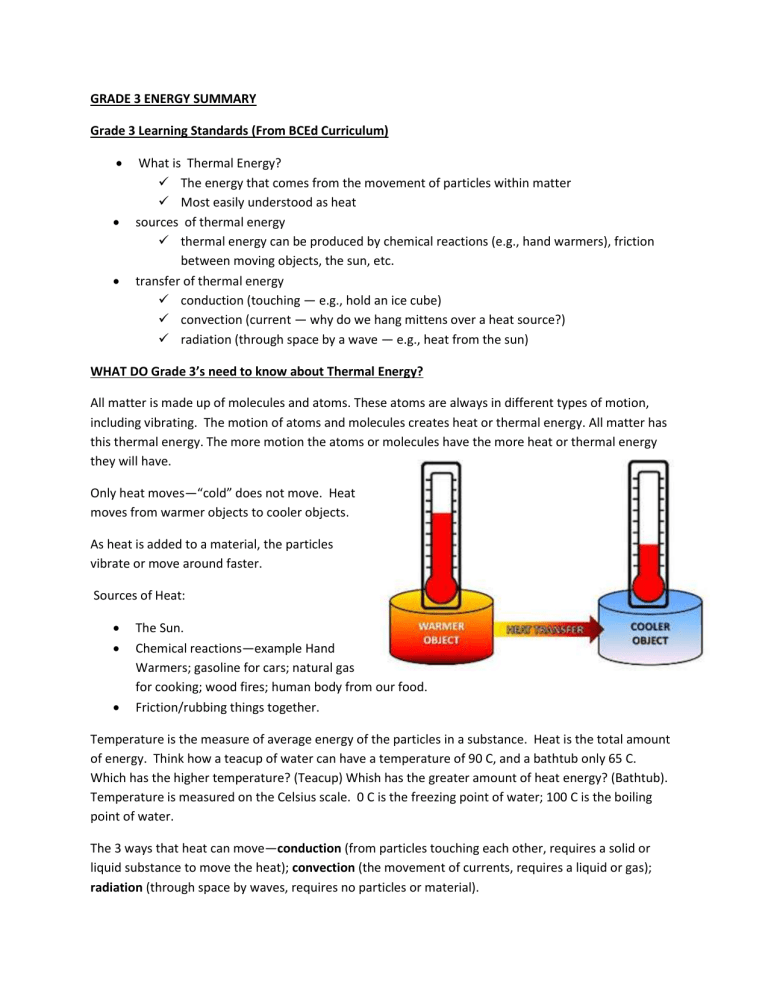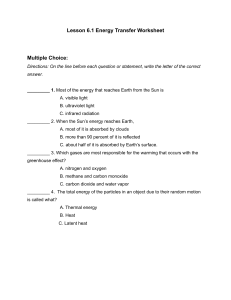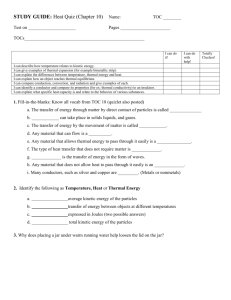
GRADE 3 ENERGY SUMMARY Grade 3 Learning Standards (From BCEd Curriculum) What is Thermal Energy? The energy that comes from the movement of particles within matter Most easily understood as heat sources of thermal energy thermal energy can be produced by chemical reactions (e.g., hand warmers), friction between moving objects, the sun, etc. transfer of thermal energy conduction (touching — e.g., hold an ice cube) convection (current — why do we hang mittens over a heat source?) radiation (through space by a wave — e.g., heat from the sun) WHAT DO Grade 3’s need to know about Thermal Energy? All matter is made up of molecules and atoms. These atoms are always in different types of motion, including vibrating. The motion of atoms and molecules creates heat or thermal energy. All matter has this thermal energy. The more motion the atoms or molecules have the more heat or thermal energy they will have. Only heat moves—“cold” does not move. Heat moves from warmer objects to cooler objects. As heat is added to a material, the particles vibrate or move around faster. Sources of Heat: The Sun. Chemical reactions—example Hand Warmers; gasoline for cars; natural gas for cooking; wood fires; human body from our food. Friction/rubbing things together. Temperature is the measure of average energy of the particles in a substance. Heat is the total amount of energy. Think how a teacup of water can have a temperature of 90 C, and a bathtub only 65 C. Which has the higher temperature? (Teacup) Whish has the greater amount of heat energy? (Bathtub). Temperature is measured on the Celsius scale. 0 C is the freezing point of water; 100 C is the boiling point of water. The 3 ways that heat can move—conduction (from particles touching each other, requires a solid or liquid substance to move the heat); convection (the movement of currents, requires a liquid or gas); radiation (through space by waves, requires no particles or material). Good conductors allow thermal energy to move easily. Good insulators prevent the movement of thermal energy. Good insulation prevents the movement of thermal energy by preventing conduction, preventing convection, and preventing radiation. CURRICULAR COMPETENCIES Questioning and predicting—can students generate their own questions? Planning and conducting—can they design and plan an experiment? Processing and analyzing data and information—can they record data and see patterns? Evaluating—can they draw conclusions from their data? Applying and innovating—can they improve their design? Communicating—can they talk, write and draw about their learning? WHY IS THERMAL ENERGY IMPORTANT? Sources of heat are very important in terms of habitable life range; in cooking; in keeping food warm or cool. Keeping body temperature stable in very hot or cold environments. Understanding how heat travels has a wide range of applications in nature, the home, architecture, mechanics. KEY VOCABULARY Heat: energy associated with the movement of atoms and molecules in any material Thermal energy: the energy that is generated and measured by heat Particles: is a very small portion of matter (we can also use atom or molecule) Motion: movement or vibration Conduction: the transfer of heat energy from one atom to another in an object due to direct contact. Convection: the transfer of heat energy that can only happen in liquids and gases, because it involves those liquids or gases physically moving; heated particles are further apart, less dense so they rise. Radiation: the transfer of heat energy in waves, which does not require any particles (for example, the sun’s heat comes to us through space, where there are no particles). Insulator: a material that reduces the flow of heat energy. Conductor: a material that easily allows the flow of heat energy. SOME INQUIRY QUESTIONS What’s the best spoon to stir a pot of soup? Why are toilet seats cold even if the air in the bathroom isn't? What’s the best natural material to use as an insulator? How did Coast Salish First Nations insulate their living quarters before colonization? What would be some advantages of using these natural insulators now? Why did Inuit traditionally build temporary winter shelters out of snow? Isn't snow cold? What has more thermal energy—a tea cup at 90 C or an ice berg? SUGGESTED PROVOCATIONS/ACTIVITIES/EXPERIMENTS Why use a thermometer? Fill a cup with very warm water (but not burning the skin) from the tap, and a cup with ice water. Label them HOT and COLD. Fill a third cup with room temperature water, label with a question mark. Have a student place a finger in the HOT cup, and another place a finger in the COLD cup. After 15-20 sec, have them move their fingers to the same ? cup. Ask them if it is warm or cool. Heat vs. Temperature Teach students to use a thermometer. Have them measure the temperature of a large container of hot water vs. a small container of hot water. Repeat the measurement each minute for 10 minutes. Why does the small container cool down more quickly? Use this to discuss HEAT versus TEMPERATURE. Sources of Heat Do a carousel with a candle, a lamp, a hand-warmer, a mitten, a hand-warmer (resusable or nonreusable), a hair dryer, sandpaper and wood (instruct to sand) and other items. Have students say whether these things make heat. If so, what is the SOURCE of the heat? Friction heat Students can investigate friction using a thermometer and their hands—taking the temperature before and after rubbing their hands. Or, fill a coffee cup with sand, tape the lid on, cover the hold with your finger and shake. Measure the temperature after different speeds of shaking. Hand Warmers Investigate the handwarmers—how do they work? How long do they last? You can also use these to measure the insulating effects of different types of cups. https://www.wired.com/2014/12/whatsinside-hot-hands/ Radiation A radiometer helps measure heat energy. If you have a south facing window, you can also do a tracing of the sun. Compare melting rates on a black plate vs. a white plate (or use different colours of plastic container lids). Conduction Use these plates to compare the difference between conductive materials and insulating materials. Have students do a “Predict, Observe, Explain” before placing the ice-cubes on them. These are available in the Thermal Energy Kit from the DLRC. https://www.teachersource.com/product/amazing-icemelting-blocks/energy Stir a hot cup with spoons of plastic, metal and wood. Which spoon conducts? How do you know? What are the properties of this cup? Convection Two ideas to engage in convection. First, fill clear cups/beakers/glasses with hot, warm and cold water. Then have students put a drop of food colouring in each. Observe after 30 sec and 1 minute and 5 minutes. Secondly, use a convection ring (available in the Thermal Energy Kit from the DLRC) to demonstrate. It is also possible to make an entire fish tank into a convection cycle: https://www.youtube.com/watch?v=B8H06ZA2xmo Insulation Test various materials using either warm water or ice water to see how temperature changes when insulated. Design and investigate the insulating properties of some natural materials used by insulation for our First Nations people: wood chips, wool and cat-tail fluff. (Information and materials in the kit from the DLRC). CROSS-CURRICULAR CONNECTIONS A Camping Spree with Mr. Magee by Chris Van Dusen—a good book to SET YOUR PURPOSE—why do we need to worry about heat? How can you camp comfortably? (Eventually, this book will be in the Thermal Energy Kit) On a Beam of Light by Jennifer Berne is the perfect anchor book for questioning and considering curiosity…. a necessary trait for scientists. INDIGENOUS PERSPECTIVES Stories about the Sun Bentwood Box cooking: https://www.youtube.com/watch?time_continue=5&v=6d9P-ODggaM Coast Salish people use racks for drying (heat from sun) and cooking fish; salmon smokehouse for drying and storing http://firstpeoplesofcanada.com/fp_groups/fp_nwc3.html Coast Salish Insulation—using bull rushes (also known as cat-tail fluff), both the leaves for weaving mats and the fluff for insulation, wool traded from Sto:Lo as a warm clothing insulation. Currently, many First Nations are exploring Solar Energy (this video is for teacher info): http://aptnnews.ca/2017/05/18/solar-panels-on-small-b-c-first-nation-make-big-impact/ ) RESOURCES Bill Nye the Science Guy on Heat (2:05) https://www.youtube.com/watch?v=f1eAOygDP5s Heat is the thermal energy that exists in matter: http://studyjams.scholastic.com/studyjams/jams/science/energylight-sound/heat.htm This is a great, old series of simple cartoons that explains all the concepts in this unit (each video is under 5 minutes): https://www.youtube.com/playlist?list=PL07249EFA9038FDC1 Episodes 20, 21, 24, 27, 28, 29 are relevant to this unit. Find a list of conductors/insulators here: https://physics.info/conduction/ References: The Physics Hypertextbook: https://physics.info SD71 Science Info (this is a great source of info for all science areas and includes FRENCH resources): https://portal.sd71.bc.ca/group/wyhzgr4/physics/grade3/Pages/Gr3physicsteacher.aspx





